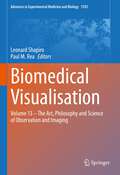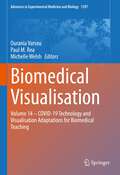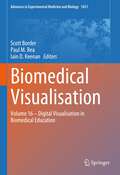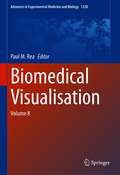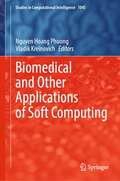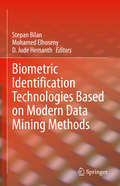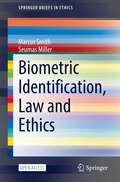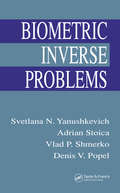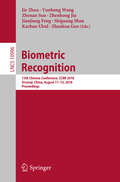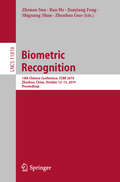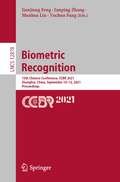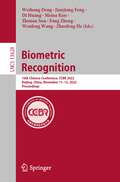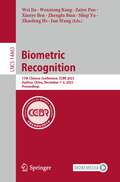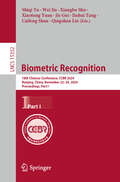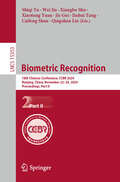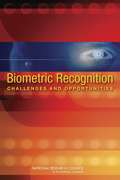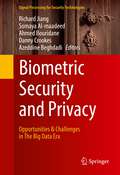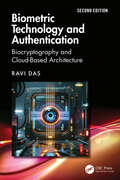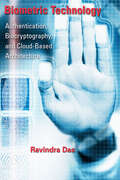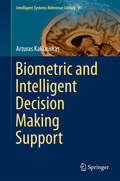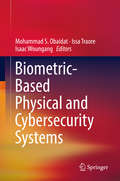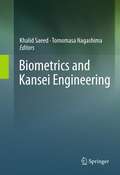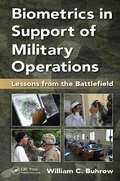- Table View
- List View
Biomedical Visualisation: Volume 13 – The Art, Philosophy and Science of Observation and Imaging (Advances in Experimental Medicine and Biology #1392)
by Leonard Shapiro Paul M. ReaThis book brings together current advances in high-technology visualisation and the age-old but science-adapted practice of drawing for improved observation in medical education and surgical planning and practice. We begin this book with a chapter reviewing the history of confusion around visualisation, observation and theory, outlining the implications for medical imaging. The authors consider the shifting influence of various schools of philosophy, and the changing agency of technology over time. We then follow with chapters on the practical application of visualisation and observation, including emerging imaging techniques in anatomy for teaching, research and clinical practice - innovation in the mapping of orthopaedic fractures for optimal orthopaedic surgical guidance - placental morphology and morphometry as a prerequisite for future pathological investigations - visualising the dural venous sinuses using volume tracing. Two chapters explore the use and benefit of drawing in medical education and surgical planning. It is worth noting that experienced surgeons and artists employ a common set of techniques as part of their work which involves both close observation and the development of fine motor skills and sensitive tool use.An in-depth look at police identikit construction from memory by eyewitnesses to crimes, outlines how an individual’s memory of a suspect’s facial features are rendered visible as a composite image.This book offers anatomy educators and clinicians an overview of the history and philosophy of medical observation and imaging, as well as an overview of contemporary imaging technologies for anatomy education and clinical practice. In addition, we offer anatomy educators and clinicians a detailed overview of drawing practices for the improvement of anatomical observation and surgical planning. Forensic psychologists and law enforcement personnel will not only benefit from a chapter dedicated to the construction of facial composites, but also from chapters on drawing and observation.
Biomedical Visualisation: Volume 14 ‒ COVID-19 Technology and Visualisation Adaptations for Biomedical Teaching (Advances in Experimental Medicine and Biology #1397)
by Paul M. Rea Ourania Varsou Michelle WelshThis book focuses on the challenges to biomedical education posed by the lockdowns and restrictions to on campus teaching brought about by the COVID-19 pandemic and highlights the tools and digital visualization technologies that have been successfully developed and used for remote teaching. Biomedical education for science, medical, dental and allied health professionals relies on teaching visual and tactile knowledge using practice-based approaches. This has been delivered for decades via on-campus lectures, workshops and laboratories, teaching practical skills as well as fundamental knowledge and understanding. However, the arrival of the COVID-19 pandemic meant that education across the globe had to pivot very quickly to be able to deliver these skills and knowledge in a predominantly online environment. This brought with it many challenges, as Higher Education staff, had to adapt to deliver these visual subjects remotely. This book addresses the challenges and solutions faced by Higher Education staff in teaching visual content in distance education. Chapters include literature reviews, original research, and pedagogical reflections for a wide range of biomedical subjects, degrees such as medicine, dentistry and veterinary sciences with examples from undergraduate and postgraduate settings. The goal of the book is to provide a compendium of expertise based on evidence gathered during the COVID-19 pandemic, as well as reflections on the challenges and lessons learned from this dramatic shift in teaching. It also presents new examples of best practices that have emerged from this experience to ensure that they are not lost as we return to on-campus learning in a new era of biomedical teaching. This book will be of interest to anyone looking for a helpful reference point when designing online or blended teaching for visual practice-based subjects.
Biomedical Visualisation: Volume 16 ‒ Digital Visualisation in Biomedical Education (Advances in Experimental Medicine and Biology #1421)
by Paul M. Rea Scott Border Iain D. KeenanWhen studying medicine, healthcare, and medical sciences disciplines, learners are frequently required to visualise and understand complex three-dimensional concepts. Consequently, it is important that appropriate modalities are used to support their learning. Recently, educators have turned to new and existing digital visualisation approaches when adapting to pandemic-era challenges and when delivering blended post-pandemic teaching.This book focuses on a range of key themes in anatomical and clinically oriented education that can be enhanced through visual understanding of the spatial three-dimensional arrangement and structure of human patients.The opening chapters describe important digital adaptations for the dissemination of biomedical education to the public and to learners. These topics are followed by reviews and reports of specific modern visualisation technologies for supporting anatomical, biomedical sciences, and clinical education. Examples include 3D printing, 3D digital models, virtual histology, extended reality, and digital simulation. This book will be of interest to academics, educators, and communities aiming to modernise and innovate their teaching. Additionally, this book will appeal to clinical teachers and allied healthcare professionals who are responsible for the training and development of colleagues, and those wishing to communicate effectively to a range of audiences using multimodal digital approaches.
Biomedical Visualisation: Volume 8 (Advances in Experimental Medicine and Biology #1260)
by Paul M. ReaThis edited book explores the use of technology to enable us to visualise the life sciences in a more meaningful and engaging way. It will enable those interested in visualisation techniques to gain a better understanding of the applications that can be used in visualisation, imaging and analysis, education, engagement and training.The reader will be able to explore the utilisation of technologies from a number of fields to enable an engaging and meaningful visual representation of the biomedical sciences, with a focus in this volume related to anatomy, and clinically applied scenarios. The first six chapters in this volume show the wide variety of tools and methodologies that digital technologies and visualisation techniques can be utilised and adopted in the educational setting. This ranges from body painting, clinical neuroanatomy, histology and veterinary anatomy through to real time visualisations and the uses of digital and social media for anatomical education. The last four chapters represent the diversity that technology has to be able to use differing realities and 3D capture in medical visualisation, and how remote visualisation techniques have developed. Finally, it concludes with an analysis of image overlays and augmented reality and what the wider literature says about this rapidly evolving field.
Biomedical Visualisation: Volume 9 (Advances in Experimental Medicine and Biology #1317)
by Paul M. ReaThis edited book explores the use of technology to enable us to visualise the life sciences in a more meaningful and engaging way. It will enable those interested in visualisation techniques to gain a better understanding of the applications that can be used in visualisation, imaging and analysis, education, engagement and training. The reader will also be able to learn about the use of visualisation techniques and technologies for the historical and forensic settings.The reader will be able to explore the utilisation of technologies from a number of fields to enable an engaging and meaningful visual representation of the biomedical sciences.In this volume, there are chapters which examine forensic and historical visualisation techniques and digital reconstruction, ultrasound, virtual learning resources and patient utilised software and hardware. The use of HoloLens as a disruptive technology is discussed as well as historical items as a feature in a modern medical curriculum. It concludes with a fascinating chapter on pulse extraction from facial videos. All in all, this volume has something for everyone whether that is faculty, students, clinicians and forensic practitioners, patients, or simply having an interest in one or more of these areas.
Biomedical and Computational Biology: Second International Symposium, BECB 2022, Virtual Event, August 13–15, 2022, Revised Selected Papers (Lecture Notes in Computer Science #13637)
by Shiping Wen Cihui YangThis book constitutes the revised selected proceedings of Second International Symposium on Biomedical and Computational Biology, BECB 2022, held as a virtual event in August 2022.The 58 full papers included in this book were carefully reviewed and selected from 135 submissions. The papers are organized in topical sections as follows: The Charge Transfer Network Model for Arbitrary Proteins Complexes; A Self-Supervised 3D/2D Registration Method for Incomplete DSA Vessels; The Potential Role of RNA "Writer" TRMT61B in the Immune Regulation of Breast Cancer; Extraction, Composition Analysis and Blood Lipid Lowering Activity of Rana chensinensis Ovum Oil.
Biomedical and Other Applications of Soft Computing (Studies in Computational Intelligence #1045)
by Vladik Kreinovich Nguyen Hoang PhuongThis book describes current and potential use of artificial intelligence and computational intelligence techniques in biomedicine and other application areas. Medical applications range from general diagnostics to processing of X-ray images to e-medicine-related privacy issues. Medical community understandably prefers methods that have been successful other on other application areas, where possible mistakes are not that critical. This book describes many promising methods related to deep learning, fuzzy techniques, knowledge graphs, and quantum computing. It also describes the results of testing these new methods in communication networks, education, environmental studies, food industry, retail industry, transportation engineering, and many other areas. This book helps practitioners and researchers to learn more about computational intelligence methods and their biomedical applications—and to further develop this important research direction.
Biometric Identification Technologies Based on Modern Data Mining Methods
by Mohamed Elhoseny D. Jude Hemanth Stepan BilanThis book emphasizes recent advances in the creation of biometric identification systems for various applications in the field of human activity. The book displays the problems that arise in modern systems of biometric identification, as well as the level of development and prospects for the introduction of biometric technologies. The authors classify biometric technologies into two groups, distinguished according to the type of biometric characteristics used. The first group uses static biometric parameters: fingerprints, hand geometry, retina pattern, vein pattern on the finger, etc. The second group uses dynamic parameters for identification: the dynamics of the reproduction of a signature or a handwritten keyword, voice, gait, dynamics of work on the keyboard, etc. The directions of building information systems that use automatic personality identification based on the analysis of unique biometric characteristics of a person are discussed. The book is intended for professionals working and conducting research in the field of intelligent information processing, information security, and robotics and in the field of real-time identification systems. The book contains examples and problems/solutions throughout.
Biometric Identification, Law and Ethics (SpringerBriefs in Ethics)
by Seumas Miller Marcus SmithThis book is open access. This book undertakes a multifaceted and integrated examination of biometric identification, including the current state of the technology, how it is being used, the key ethical issues, and the implications for law and regulation. The five chapters examine the main forms of contemporary biometrics–fingerprint recognition, facial recognition and DNA identification– as well the integration of biometric data with other forms of personal data, analyses key ethical concepts in play, including privacy, individual autonomy, collective responsibility, and joint ownership rights, and proposes a raft of principles to guide the regulation of biometrics in liberal democracies.Biometric identification technology is developing rapidly and being implemented more widely, along with other forms of information technology. As products, services and communication moves online, digital identity and security is becoming more important. Biometric identification facilitates this transition. Citizens now use biometrics to access a smartphone or obtain a passport; law enforcement agencies use biometrics in association with CCTV to identify a terrorist in a crowd, or identify a suspect via their fingerprints or DNA; and companies use biometrics to identify their customers and employees. In some cases the use of biometrics is governed by law, in others the technology has developed and been implemented so quickly that, perhaps because it has been viewed as a valuable security enhancement, laws regulating its use have often not been updated to reflect new applications. However, the technology associated with biometrics raises significant ethical problems, including in relation to individual privacy, ownership of biometric data, dual use and, more generally, as is illustrated by the increasing use of biometrics in authoritarian states such as China, the potential for unregulated biometrics to undermine fundamental principles of liberal democracy. Resolving these ethical problems is a vital step towards more effective regulation.
Biometric Inverse Problems
by Svetlana N. Yanushkevich Vlad P. Shmerko Adrian Stoica Denis V. PopelTraditional methods of biometric analysis are unable to overcome the limitations of existing approaches, mainly due to the lack of standards for input data, privacy concerns involving use and storage of actual biometric data, and unacceptable accuracy. Exploring solutions to inverse problems in biometrics transcends such limits and allows rich analysis of biometric information and systems for improved performance and testing. Although some particular inverse problems appear in the literature, until now there has been no comprehensive reference for these problems. Biometric Inverse Problems provides the first comprehensive treatment of biometric data synthesis and modeling. This groundbreaking reference comprises eight self-contained chapters that cover the principles of biometric inverse problems; basics of data structure design; new automatic synthetic signature, fingerprint, and iris design; synthetic faces and DNA; and new tools for biometrics based on Voronoi diagrams. Based on the authors' vast experience in the field, the book authoritatively examines new approaches and methodologies in both direct and inverse biometrics, providing invaluable analytical and benchmarking tools. The authors include case studies, examples, and implementation codes for practical illustration of the methods. Loaded with approximately 200 figures, 60 problems, 50 MATLAB® code fragments, and 200 examples, Biometric Inverse Problems sets the standard for innovation and authority in biometric data synthesis, modeling, and analysis.
Biometric Recognition: 13th Chinese Conference, CCBR 2018, Urumqi, China, August 11-12, 2018, Proceedings (Lecture Notes in Computer Science #10996)
by Jie Zhou Zhenhua Guo Shiguang Shan Yunhong Wang Zhenan Sun Jianjiang Feng Zhenhong Jia Kurban UbulThe LNCS volume 10996 constitutes the proceedings of the 13th Chinese Conference on Biometric Recognition, held in Urumchi, China, in August 2018. The 79 full papers and 67 poster papers presented were carefully reviewed and selected from 112 submissions. The papers cover a wide range of topics such as Biometrics, Speech recognition, Activity recognition and understanding, Online handwriting recognition, System forensics, Multi-factor authentication, Graphical and visual passwords.
Biometric Recognition: 14th Chinese Conference, CCBR 2019, Zhuzhou, China, October 12–13, 2019, Proceedings (Lecture Notes in Computer Science #11818)
by Ran He Zhenhua Guo Shiguang Shan Zhenan Sun Jianjiang FengThe LNCS volume 11818 constitutes the proceedings of the 14th Chinese Conference on Biometric Recognition, held in Zhuzhou, China, in October 2019. The 56 papers presented in this book were carefully reviewed and selected from 74 submissions. The papers cover a wide range of topics such as face recognition and analysis; hand-based biometrics; eye-based biometrics; gesture, gait, and action; emerging biometrics; feature extraction and classification theory; and behavioral biometrics.
Biometric Recognition: 15th Chinese Conference, CCBR 2021, Shanghai, China, September 10–12, 2021, Proceedings (Lecture Notes in Computer Science #12878)
by Jianjiang Feng Junping Zhang Manhua Liu Yuchun FangThe LNCS volume 12878 constitutes the proceedings of the 15th Chinese Conference on Biometric Recognition, held in Shanghai, China, in September 2021.The 53 papers presented in this book were carefully reviewed and selected from 72 submissions. The papers cover a wide range of topics such as multi-modal biometrics and emerging biometrics; hand biometrics; facial biometrics; and speech biometrics.
Biometric Recognition: 16th Chinese Conference, CCBR 2022, Beijing, China, November 11–13, 2022, Proceedings (Lecture Notes in Computer Science #13628)
by Zhenan Sun Jianjiang Feng Wenfeng Wang Meina Kan Weihong Deng Di Huang Fang Zheng Zhaofeng HeThis book constitutes the proceedings of the 16th Chinese Conference on Biometric Recognition, CCBR 2022, which took place in Beijing, China, in November 2022.The 70 papers presented in this volume were carefully reviewed and selected from 115 submissions. The papers cover a wide range of topics such as Fingerprint, Palmprint and Vein Recognition; Face Detection, Recognition and Tracking; Gesture and Action Recognition; Affective Computing and Human-Computer Interface; Speaker and Speech Recognition; Gait, Iris and Other Biometrics; Multi-modal Biometric Recognition and Fusion; Quality Evaluation and Enhancement of Biometric Signals; Animal Biometrics; Trustworthy, Privacy and Personal Data Security; Medical and Other Applications.
Biometric Recognition: 17th Chinese Conference, CCBR 2023, Xuzhou, China, December 1–3, 2023, Proceedings (Lecture Notes in Computer Science #14463)
by Jun Wang Shiqi Yu Zhaofeng He Wei Jia Wenxiong Kang Zaiyu Pan Xianye Ben Zhengfu BianThis book constitutes the proceedings of the 17th Chinese Conference, CCBR 2023, held in Xuzhou, China, during December 1–3, 2023. The 41 full papers included in this volume were carefully reviewed and selected from 79 submissions. The volume is divided in topical sections named: Fingerprint, Palmprint and Vein Recognition; Face Detection, Recognition and Tracking; Affective Computing and Human-Computer Interface; Trustworthy, Privacy and Personal Data Security; Medical and Other Applications.
Biometric Recognition: 18th Chinese Conference, CCBR 2024, Nanjing, China, November 22–24, 2024, Proceedings, Part I (Lecture Notes in Computer Science #15352)
by Caifeng Shan Xiaotong Yuan Qingshan Liu Shiqi Yu Jinhui Tang Wei Jia Xiangbo Shu Jie GuiThis two-volume set, LNCS 15352 and LNCS 15353, constitutes the proceedings of the 18th Chinese Conference on Biometric Recognition, CCBR 2024, held in Nanjing, China, during November 22–24, 2024. The 52 full papers presented here were carefully reviewed and selected from 82 submissions. These papers have been categorized under the following topical sections in these two volumes: - Part I: Fingerprint, Palmprint and Vein Recognition; Face Detection, Recognition and Tracking. Part II: Face Detection, Recognition and Tracking; Affective Computing and Human-Computer Interface; Gait, Iris and Other Biometrics; Trustworthy, Privacy and Personal Data Security; Medical and Other Applications.
Biometric Recognition: 18th Chinese Conference, CCBR 2024, Nanjing, China, November 22–24, 2024, Proceedings, Part II (Lecture Notes in Computer Science #15353)
by Caifeng Shan Xiaotong Yuan Qingshan Liu Shiqi Yu Jinhui Tang Wei Jia Xiangbo Shu Jie GuiThis two-volume set, LNCS 15352 and LNCS 15353, constitutes the proceedings of the 18th Chinese Conference on Biometric Recognition, CCBR 2024, held in Nanjing, China, during November 22–24, 2024. The 52 full papers presented here were carefully reviewed and selected from 82 submissions. These papers have been categorized under the following topical sections in these two volumes: - Part I: Fingerprint, Palmprint and Vein Recognition; Face Detection, Recognition and Tracking. Part II: Face Detection, Recognition and Tracking; Affective Computing and Human-Computer Interface; Gait, Iris and Other Biometrics; Trustworthy, Privacy and Personal Data Security; Medical and Other Applications.
Biometric Recognition: Challenges and Opportunities
by National Research Council of the National AcademiesBiometric recognition--the automated recognition of individuals based on their behavioral and biological characteristic--is promoted as a way to help identify terrorists, provide better control of access to physical facilities and financial accounts, and increase the efficiency of access to services and their utilization. Biometric recognition has been applied to identification of criminals, patient tracking in medical informatics, and the personalization of social services, among other things. In spite of substantial effort, however, there remain unresolved questions about the effectiveness and management of systems for biometric recognition, as well as the appropriateness and societal impact of their use. Moreover, the general public has been exposed to biometrics largely as high-technology gadgets in spy thrillers or as fear-instilling instruments of state or corporate surveillance in speculative fiction. Now, as biometric technologies appear poised for broader use, increased concerns about national security and the tracking of individuals as they cross borders have caused passports, visas, and border-crossing records to be linked to biometric data. A focus on fighting insurgencies and terrorism has led to the military deployment of biometric tools to enable recognition of individuals as friend or foe. Commercially, finger-imaging sensors, whose cost and physical size have been reduced, now appear on many laptop personal computers, handheld devices, mobile phones, and other consumer devices. Biometric Recognition: Challenges and Opportunities addresses the issues surrounding broader implementation of this technology, making two main points: first, biometric recognition systems are incredibly complex, and need to be addressed as such. Second, biometric recognition is an inherently probabilistic endeavor. Consequently, even when the technology and the system in which it is embedded are behaving as designed, there is inevitable uncertainty and risk of error. This book elaborates on these themes in detail to provide policy makers, developers, and researchers a comprehensive assessment of biometric recognition that examines current capabilities, future possibilities, and the role of government in technology and system development.
Biometric Security and Privacy: Opportunities & Challenges in The Big Data Era (Signal Processing for Security Technologies)
by Ahmed Bouridane Richard Jiang Somaya Al-Maadeed Danny Crookes Azeddine BeghdadiThis book highlights recent research advances on biometrics using new methods such as deep learning, nonlinear graph embedding, fuzzy approaches, and ensemble learning. Included are special biometric technologies related to privacy and security issues, such as cancellable biometrics and soft biometrics. The book also focuses on several emerging topics such as big data issues, internet of things, medical biometrics, healthcare, and robot-human interactions. The authors show how these new applications have triggered a number of new biometric approaches. They show, as an example, how fuzzy extractor has become a useful tool for key generation in biometric banking, and vein/heart rates from medical records can also be used to identify patients. The contributors cover the topics, their methods, and their applications in depth.
Biometric Technology and Authentication: Biocryptography and Cloud-Based Architecture
by Ravi DasThis book is an update to the first edition of this book. Some of the updates include newer images and an extensive review as to how both AWS and Microsoft Azure can be used to host a biometrics in the cloud infrastructure, which will be a hot topic going into 2025 and beyond. Finally, the last chapter of this book previews some of the latest trends for biometric technology going into 2025 and beyond.
Biometric Technology: Authentication, Biocryptography, and Cloud-Based Architecture
by Ravi DasMost biometric books are either extraordinarily technical for technophiles or extremely elementary for the lay person. Striking a balance, this book is geared toward the business, IT, or security manager required to make purchasing, migration, or adoption decisions. Presenting technical background on the various biometric technologies and how they work, it looks at optimal application in various settings and their respective strengths and weaknesses considering ease of use, false positives and negatives, and privacy and security issues. It also discusses exciting trends in biotechnology such as biocryptography and biometrics in the cloud.
Biometric and Intelligent Decision Making Support (Intelligent Systems Reference Library #81)
by Arturas KaklauskasThis book presents different methods for analyzing the body language (movement, position, use of personal space, silences, pauses and tone, the eyes, pupil dilation or constriction, smiles, body temperature and the like) for better understanding people's needs and actions, including biometric data gathering and reading. Different studies described in this book indicate that sufficiently much data, information and knowledge can be gained by utilizing biometric technologies. This is the first, wide-ranging book that is devoted completely to the area of intelligent decision support systems, biometrics technologies and their integrations. This book is designated for scholars, practitioners and doctoral and master's degree students in various areas and those who are interested in the latest biometric and intelligent decision making support problems and means for their resolutions, biometric and intelligent decision making support systems and the theory and practice of their integration and the opportunities for the practical use of biometric and intelligent decision making support.
Biometric-Based Physical and Cybersecurity Systems
by Isaac Woungang Mohammad S. Obaidat Issa TraoreThis book presents the latest developments in biometrics technologies and reports on new approaches, methods, findings, and technologies developed or being developed by the research community and the industry. The book focuses on introducing fundamental principles and concepts of key enabling technologies for biometric systems applied for both physical and cyber security. The authors disseminate recent research and developing efforts in this area, investigate related trends and challenges, and present case studies and examples such as fingerprint, face, iris, retina, keystroke dynamics, and voice applications . The authors also investigate the advances and future outcomes in research and development in biometric security systems. The book is applicable to students, instructors, researchers, industry practitioners, and related government agencies staff. Each chapter is accompanied by a set of PowerPoint slides for use by instructors.
Biometrics and Kansei Engineering
by Tomomasa Nagashima Khalid SaeedBiometrics and Kansei Engineering is the first book to bring together the principles and applications of each discipline. The future of biometrics is in need of new technologies that can depend on people's emotions and the prediction of their intention to take an action. Behavioral biometrics studies the way people walk, talk, and express their emotions, and Kansei Engineering focuses on interactions between users, products/services and product psychology. They are becoming quite complementary. This book also introduces biometric applications in our environment, which further illustrates the close relationship between Biometrics and Kansei Engineering. Examples and case studies are provided throughout this book. Biometrics and Kansei Engineering is designed as a reference book for professionals working in these related fields. Advanced-level students and researchers studying computer science and engineering will find this book useful as a reference or secondary text book as well.
Biometrics in Support of Military Operations: Lessons from the Battlefield
by William C. BuhrowBiometrics in Support of Military Operations: Lessons from the Battlefield examines and evaluates recent U.S. military experiences in Iraq and Afghanistan in the context of the use of biometrics and related technologies. The book takes a comprehensive look at how biometrics has been used to support various military operations and suggests ways that its uses can be further developed. It fills a void in understanding how to incorporate biometrics by providing a guide to develop and establish formal operational roles and procedures when applying the technology. Written in an informal style that makes it accessible to people who are not necessarily operators or technicians of biometrics technologies, this book bridges an existing gap to better educate leaders inside and outside of the U.S. military on the far-reaching potential of biometrics in support of tactical operations. It argues that the gap between those inside and outside the military is the result of failure to document lessons learned from battle experience, as well as a lack of a combined vision among the Joint Forces to fully recognize and exploit the capabilities of biometrics for enhanced future success. This book fills that gap. Biometrics has great potential as an effective tool if properly developed and utilized. The book concludes with a look at the future of emerging applications for the military but also considers a wider range of deployment of biometrics outside the military, such as in governmental organizations, including foreign diplomacy. Biometrics can be applied to any operational area that requires accurate and rapid identification of unknown individuals in order to support its operations and protect personnel and resources. Biometrics in Support of Military Operations is an important beginning point in an emerging field for gaining understanding and better mastery of biometrics.
